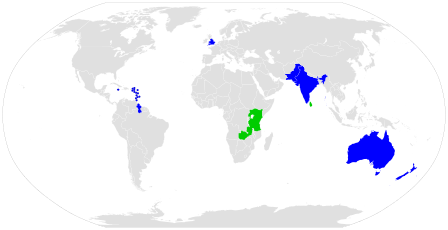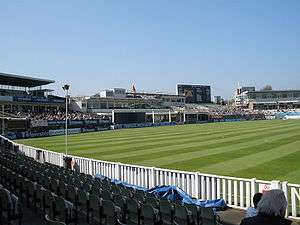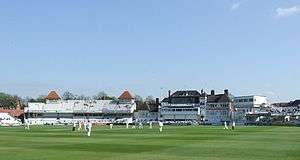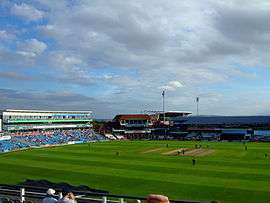1975 Cricket World Cup
| Dates | 7 June – 21 June |
|---|---|
| Administrator(s) | International Cricket Conference |
| Cricket format | One Day International |
| Tournament format(s) | Round robin and Knockout |
| Host(s) | England |
| Champions |
|
| Participants | 8 |
| Matches played | 15 |
| Attendance | 158,000 (10,533 per match) |
| Most runs |
|
| Most wickets |
|
The 1975 Cricket World Cup (officially called the Prudential Cup) was the first edition of the Cricket World Cup, organised by the International Cricket Conference (ICC). It was held from 7 to 21 June 1975 in England.
The tournament was sponsored by Prudential Assurance Company and had eight participating countries: the six Test-playing teams of the time (Australia, England, India, New Zealand, Pakistan and the West Indies), plus leading Associate nations Sri Lanka and, for the only time, East Africa. The teams were divided into two groups of four, with each team playing the other teams in their group once; the top two from each group qualified for the semi-finals, with the winners of these matches meeting in the final. Each match consisted of 60 overs per team and was played in traditional white clothing and with red balls; all were played during the day and hence started early.
England, New Zealand West Indies and Australia were the teams to qualify for the semi-finals, making this the only World Cup thus far in which no team from the Indian subcontinent made this stage. Australia defeated England and the West Indies beat New Zealand, before the West Indies, the pre-tournament favourites, defeated Australia in the final at Lord's by 17 runs to become the first World Cup winners.
The opening match of the tournament featured one of the most bizarre batting efforts in one-day history, by India's Sunil Gavaskar. After England scored 334/4, with Dennis Amiss making 137, Gavaskar batted through the full 60 overs for 36 not out, prompting several pitch invasions from unhappy Indian fans.
Format
The format of the first world cup was 2 groups of four teams each, and each team playing each other. The top two team from each group then advance to the Semi Finals, where the winners then advance (qualified) for the finals.
The first Cricket World Cup was played in England on seven different venues. A total of 16 matches were played in the 1975 Cricket World Cup, including two semi-finals and a final.[1]
Participants

England hosted each of the first three competitions. The ICC decided that England should host the first tournament because it was ready to put the resources needed in organising the inaugural event. India proposed that it should host the third Cricket World Cup, but most ICC members believed England was a more suitable venue because longer period of daylight in June. This meant that a match could be completed in one day.[2] The following 8 teams qualified for the final tournament. Sri Lanka and East Africa were the only two teams without Test status.
| Team | Method of qualification | Previous best performance | Rank | Group |
|---|---|---|---|---|
| Host | Debut | 1 | A | |
| Full Members | Debut | 5 | A | |
| Debut | 3 | B | ||
| Debut | 6 | B | ||
| Debut | 2 | B | ||
| Debut | 4 | A | ||
| Invitation | Debut | - | B | |
| Debut | - | A |
Venues
| London | London | |
|---|---|---|
| Lord's Cricket Ground | The Oval | |
| Capacity: 30,000 | Capacity: 23,500 | |
 |
 | |
| Birmingham | Manchester | |
| Edgbaston Cricket Ground | Old Trafford Cricket Ground | |
| Capacity: 21,000 | Capacity: 19,000 | |
 |
| |
| Nottingham | Leeds | |
| Trent Bridge | Headingley Stadium | |
| Capacity: 15,350 | Capacity: 14,000 | |
 |
 |
Squads
Group stage
Group A
| Team | Pts | Pld | W | L | NR | RR |
|---|---|---|---|---|---|---|
| 12 | 3 | 3 | 0 | 0 | 4.94 | |
| 8 | 3 | 2 | 1 | 0 | 4.07 | |
| 4 | 3 | 1 | 2 | 0 | 3.24 | |
| |
0 | 3 | 0 | 3 | 0 | 1.90 |
Group B
| Team | Pts | Pld | W | L | NR | RR |
|---|---|---|---|---|---|---|
| 12 | 3 | 3 | 0 | 0 | 4.35 | |
| 8 | 3 | 2 | 1 | 0 | 4.43 | |
| 4 | 3 | 1 | 2 | 0 | 4.45 | |
| 0 | 3 | 0 | 3 | 0 | 2.78 |
7 June 1975 Scorecard |
| v |
87/1 (20.4 overs) |
West Indies won by 9 wickets Old Trafford, Manchester, England |
11 June 1975 Scorecard |
| v |
267/9 (59.4 overs) |
West Indies won by 1 wicket Edgbaston, Birmingham, England |
14 June 1975 Scorecard |
| v |
195/3 (46 overs) |
West Indies won by 7 wicket Kennington Oval, London, England |
Knockout stage
| Semi-finals | Final | ||||||
| 18 June – Leeds | |||||||
| |
93 | ||||||
| |
94/6 | ||||||
| 21 June – London | |||||||
| |
274 | ||||||
| |
291/8 | ||||||
| 18 June – London | |||||||
| |
158 | ||||||
| |
159/5 | ||||||
Semifinals
In the best World Cup performance to date by a bowler, Gary Gilmour took six for fourteen, as England were bowled out for 93 (36.2 overs), after having fallen to 37/7. Australia initially suffered a collapse just as dramatic, falling to 39/6, before Gilmour (28 from 28 balls, 5 fours) brought them home in a fantastic all-round performance.
The West Indies won the toss and sent New Zealand in to bat first. New Zealand batted well against the bowling at first, reaching 98/1. However, when captain Glenn Turner (36 from 74 balls, 3 fours) and Geoff Howarth (51 from 93 balls, 3 fours) fell, breaking a second-wicket partnership of 90 runs, New Zealand lost 9/60 to fall to 158 (all out, 52.2 overs). The West Indies responded, with Alvin Kallicharan (72 from 92 balls, 7 fours, 1 six) and Gordon Greenidge (55 from 95 balls, 9 fours, 1 six) sharing a second-wicket partnership of 125 runs, that brought the West Indies to their target.
18 June 1975 Scorecard |
| v |
159/5 (40.1 overs) |
West Indies won by 5 wickets Kennington Oval, London, England |
Final
In the final, the West Indies beat Australia by 17 runs, after an accomplished innings from captain Clive Lloyd (102 from 85 balls, 12 fours, 2 sixes). The Australian innings was marked by top-order batsmen being run out when going for runs after misfields. A total of five of their team were run out, three by Vivian Richards. There was no 'Man of the Series' awarded in 1975.
21 June 1975 Scorecard |
| 291/8 (60 overs) |
v |
West Indies won by 17 runs Lord's, London, England Attendance: 24,000 |
Statistics
|
|


.svg.png)